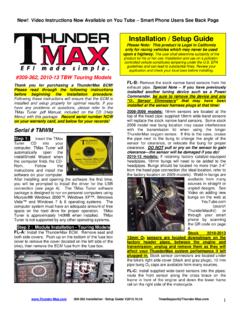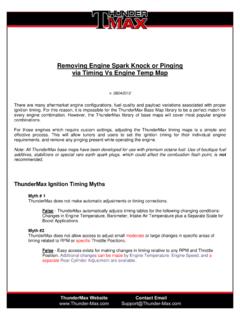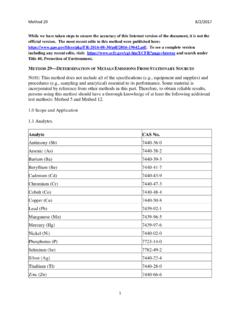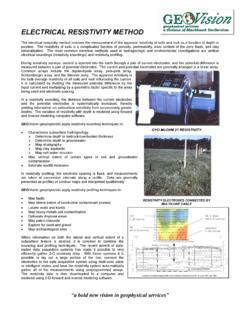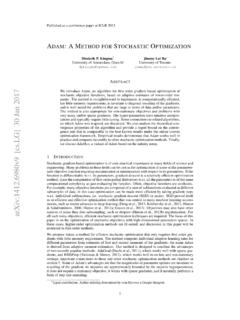Transcription of Adjusting Timing for Ping - ThunderMax
1 Adjusting Timing for Ping If you are experiencing ping at specific locations (TPS vs RPM), this document explains how to make Timing adjustments to remove that pinging. The first section explains Adjusting the Timing vs TPS @ rpm pages to correct for ping. A simpler approach follows below that which is used in many cases satisfactorily. It is up to you on what your needs (and skill) are to choose the Timing modification method which best works for you. Legend Notes: The YELLOW points above are where the ignition Timing points were before being moved (Historical last position). These points are for reference only and have NO impact on Timing . The BLUE (Red if you link and read the map) points above are the ACTUAL map Timing points which will be applied.
2 HINT: If you make adjustments to Timing , SAVE your map to your computer so that you can later open it to view what you have done by examining the YELLOW vs BLUE points. I save it to a name such as TimingAdj-1 as an example. Closed to Light Throttle Region (Gray Area): Creating Smooth Throttle Transitions This region will NEVER experience ping. This is the area which is only experienced during closed or very light throttle conditions, such as revving the engine or applying light throttle during transition from close throttle perhaps while coasting downhill or around a corner. The Timing in this region should have a smooth transition from lower to higher rpms. For example, if idle (768,1024,128) rpms are all at 18 degrees of Timing then a smooth gradient transition should occur as the rpms increase.
3 An example would be the following values: (Your values may be different, it s the pattern of transition we like to see) It is preferred to have all idle rpm Timing at the same setting. This helps eliminate idle hunt due to Timing changes. 768 @ 18 degrees 1024 @ 18 degrees 1280 @ 18 degrees Next, it is preferred that the increasing rpm pages have gradually increasing Timing . This provides smooth rpm transitions at Light to NO load , such as revving the engine on the kick stand. 1536 @ 22 degrees 1792 @ 25 degrees 2048 @ 30 degrees 2340 @ 32 degrees 2560 @ 34 degrees and so You can test these values by the following method. While on the kick stand VERY CAREFULLY try to advance the engine RPM 100 rpm at a time and hold at that rpm.
4 For example 1200,1300,1400 up to 2500 rpm. If while doing this, you experience the RPM seeming to hang or stop increasing even though you continue to increase the throttle position, then the Timing at that rpm, in this REGION perhaps needs to be advanced. When properly set, you will be able to fully control the RPM as you slowly and steadily advance the throttle. Tuning this RPM will produce smooth throttle/rpm transitions from close throttle to higher rpms. Such as is experienced when applying slight throttle increases to coast around a corner . Normal Steady Riding Region (Green Area): Steady Cruise, Level Road. It would be VERY RARE to experience ping in this region.
5 The engine is under such LIGHT load that advanced Timing simply causes irregular/jerky engine operation, maybe even accompanied by exhaust popping . Fuel economy may also be affected by this region but changes to Timing will have little noticeable affect. This area is best left as is unless significant problems are experienced. It would take lots of testing to determine a better curve in this area. You will also notice that this is the region where the Timing falls away / reduces sharply (downhill slope). The reason for this is the engine is transitioning from LIGHT load to NORMAL load so Timing needs be removed. Throttle Roll On Region (Blue Area): This area is experienced when passing or climbing a hill.
6 The Throttle Roll On area is where 95% of all PING occurs. This area is referred to as the Belly of the Timing curve (due to its inherent saggy shape). Particularly at LOWER rpm (where engine LOAD is highest) the Belly is deeper. As rpm increase the Belly normally reduces and may even not exist . Full Throttle Region (Red Area): The Full Throttle region will usually exhibit PING if Throttle Roll On is producing PING, But NOT always ! The Full Throttle region of the curve many times has more advanced Timing . This advanced Timing will occur JUST at Full Throttle and Slightly below. The Full Throttle region begins at the end of the Timing curve Belly. Full Throttle Timing is quite easy to adjust for obvious reasons.
7 It s not hard to find Full Throttle! Identify Where to Make Adjustments (Rules and Methods) If you are experiencing PING during Throttle Roll On, and yet if you apply Full Throttle the PING quits, then lowering only the Timing Belly will correct that condition. If you are experiencing PING during Throttle Roll On, and yet if you apply Full Throttle the PING remains the same, then BOTH the Belly and the Full Throttle regions should be lowered equally. If you are experiencing PING during Throttle Roll On, and yet if you apply Full Throttle the PING is worse, then BOTH the Belly and the Full Throttle regions should be lowered but the Full Throttle region should be lowered more.
8 If you have NO PING except at FULL THROTTLE, then only the FULL THROTTLE area should be lowered. How Much to Adjust the Timing It is hard to describe the adjustment required because of different peoples perception on how severe the ping is. Here are the Rules I use in determining how much Timing to remove to correct for ping. Very Light Ping: Engine Ping which is a skipping (not a regular tap tap tap) and very irregular and hard to hear. Light pinging will definitely be occurring on every cylinder firing. For Very Light Ping, a -1 to -2 degree retarding of the Timing is first used. Most people will not even bother to adjust because it is so light and infrequent. Moderate Ping: Engine Ping which is more regular and almost pings to the rhythm of the rpm.
9 It is NOT totally constant. The rider feels he needs to adjust it . For Moderate Ping a -3 degrees retarding of the Timing should be first used. Heavy Ping: Engine Ping which is totally in rhythm with the engine cylinder firing is considered heavy ping. For Heavy Ping as much as -5 degrees or more may be required. I may apply -3 degrees to help zero in on the area and region needing adjustment then retest. Severe Ping: Engine Ping which is so severe you IMMEDIATELY get out of the throttle. It is like large marbles shaking in a jar, loudly! In extreme cases I have removed as much as -7 and -8 degrees to remove Severe Ping. I would start with -5 degrees to help zero in on the area and region needing adjustment then retest.
10 Testing For Ping Make sure the engine is at normal operating temperatures. A 70 degree F day after cruising for 15 minutes should do it. Test by doing normal steady state cruise and THEN slowly apply throttle. Visualize the throttle REGION you are passing through as you listen for ping. Remember, the VERY MOMENT you begin to apply throttle from steady state you WILL be moving into the Belly of the Timing curve. You should be able to detect which region the ping is coming from. After some experience in making adjustments and the results, you will quickly learn to identify where adjustments are needed . If you do not have a tachometer, consider that at normal riding speeds from 30 50 mph you are most likely in the 2000 2500 rpm range.


